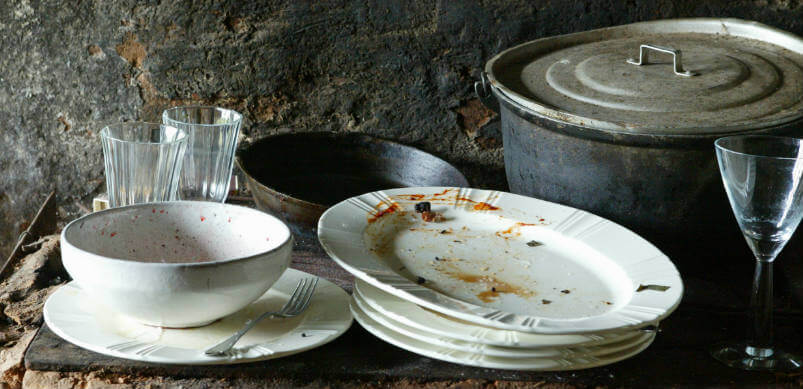
Who Are You Eating With Tonight?
January 20, 2016 | Cleaning Tips | No comments
A common ice-breaker at dinner parties is the question “who dead or alive would you have a meal with, and why?” It can be a difficult question to answer, yet it always breaks the ice.
But we’ve got another question to ask…“who are you eating with tonight?”
Chances are you’re eating with family or friends. Yet there are likely to be a number of other unwanted visitors at your table this mealtime, particularly as your kitchen isn’t likely to be as clean as you think.
Your kitchen is likely to be a hotbed for germs and bacteria, with research suggesting the kitchen sink typically contains 100,000 times more germs than your bathroom. But the sink isn’t the only place to harbour germs in your kitchen – as you’ll find out below.
Kitchen Worktops: A Hotbed for Bacteria:
From preparing various meals on, to holding dirty pots and pans before they are placed in the dishwasher / washed up, the kitchen worktop comes into contact with a lot of objects. As a result, research conducted in 2007 revealed public toilets were 85% cleaner than domestic food preparation areas, with the latter likely to harbour 10 times more bacteria than your toilet seat.
Keeping your kitchen worktop clean, however, needn’t be a difficult task – but it is something which you should do every time you use your kitchen, and part of the cleaning process includes:
- Cleaning worktops before you start preparing food
- Wipe up any spilled food straight away
- Wash surfaces thoroughly after they’ve been touched by raw food – including meat, vegetables, and raw eggs
How you clean your kitchen worktop will depend on what it is made out of, for example, marble and ceramic surfaces should be cleaned with one part bleach to four parts water. The solution should then be sprinkled over the surface before being scrubbed with an old toothbrush.
For granite worktops, it’s recommended to use mild soapy water with a soft cloth, and then to wipe it down in the same way as you’d wash any other surface.
Chopping Boards: Which are More Hygienic, Wooden or Plastic?
Despite many debates, there is no scientific proof that a plastic or wooden chopping board is more hygienic than the other.
Your chopping boards, if they haven’t been disinfected thoroughly, are also a cause for e-coli spreading in the home, which can cause serious illness to you and your loved ones.
For those with a wooden chopping board, if it is covered in scratches and grooves due to the knife coming into contact with it, it is possible to rejuvenate it – and doing so can keep any bacteria and germs which may be harbouring in it, at bay.
To rejuvenate your wooden chopping board, sand away any defects using coarse sandpaper. Once the scratches have been removed, “raise the grain” by wiping the chopping board with a slightly damp sponge, before sanding it for a final time with fine sandpaper.
With the grain raised, pour a small amount of olive oil onto the centre of the board and rub it with a soft, lint-free cloth, before allowing the oil time to soak into the wood. Once the oil has soaked in, repeat this step again. [source: http://www.theguardian.com/lifeandstyle/2009/aug/23/how-to-refresh-chopping-board]
Unfortunately, when plastic chopping boards become badly worn it isn’t possible to rejuvenate them, and instead, they will need to be replaced with a new chopping board.
Kitchen Accessories & Utensils: Harbour More Germs Than You’d Think:
Our kitchens are full of various accessories and utensils, from pasta makers and blenders to tea towels and wooden spoons. But did you know that many of these harbour germs and bacteria?
In fact, tea towels and dishcloths are a hotbed for bacteria and can be a main cause of germs spreading throughout your kitchen and home. The reason for this is because they hold moisture, creating perfect conditions for bacteria to survive, and many of us use them for multiple tasks in the home – increasing the risk of germs and bacteria spreading.
To help reduce the risk of our tea towels and dishcloths spreading germs and bacteria, it is recommended that our tea towels are washed on a hot wash every week, whilst our dish clothes should be replaced as frequently.
It isn’t just tea towels and dishcloths which can harbour germs though, other utensils such as the wooden spoons many of us use when cooking is also prime hotspots for the build-up of bacteria and germs, whilst washing up rather than using a dishwasher could be doing more harm than good in the fight against bacteria.
Telltale signs your wooden spoon(s) are suffering from a build-up of bacteria include:
- Cracks which provide the perfect hiding place for bacteria
- Spoon becoming soft to touch – a sign the wood is rotting
- Wood is turning a dark colour – again, another sign the wood is rotting
As for washing up by hand, although this will help to clean your pots and pans it’s unlikely to be killing off as much bacteria as you would think. This is because to effectively kill off most household bacteria, water must reach a temperature of 140⁰F. Such a temperature is easily reached in a dishwasher, whilst most boilers will only heat water to 120⁰F.
Appliances: Trusted With Your Food…But Home to Bacteria:
From cookers to fridges, our kitchen appliances are a hotbed for bacteria. Your cooker comes into contact with a wide range of bacteria caused by food spills and splatters, whilst your fridge’s salad drawer has up to 8,000 bacteria colonies per square metre – 750 times the level of bacteria considered safe.
Key to keeping bacteria levels down in your fridge is to ensure your fridge is kept at the correct temperature – and this should be between 1⁰C and 4⁰C – as this helps not only to keep food fresh, but stops any bacteria already lurking from multiplying.
Other steps you can take to keep bacteria levels down in your fridge include:
- Keeping the door closed for as long as possible, this stops hot air from getting into the appliance which can result in bugs multiplying.
- Not keeping too much (or too little) food in the appliance. Too much food stored incorrectly can increase the risk of bacteria forming.
- Regularly cleaning your fridge – as per the advice outlined in our “3 Ways to Clean Your Fridge on Clean Out Your Fridge Day”.
As for your cooker, the easiest way to keep bacteria at bay is to regularly clean the appliance. Taking the time to regularly clean your kitchen surfaces, utensils and appliances can help prevent you from eating with any unwanted guests, meaning you can enjoy your favourite meal with your loved ones.
Tags: Cleaning Tips

